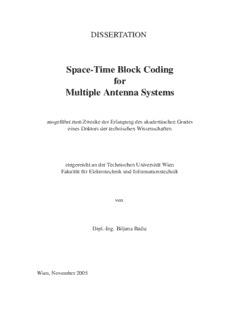Table Of ContentDISSERTATION
Space-Time Block Coding
for
Multiple Antenna Systems
ausgefu¨hrt zum Zwecke der Erlangung des akademischen Grades
eines Doktors der technischen Wissenschaften
eingereicht an der Technischen Universita¨t Wien
Fakulta¨t fu¨r Elektrotechnik und Informationstechnik
von
Dipl.-Ing. Biljana Badic
Wien, November 2005
unterderLeitungvon
Univ. Prof. Dr. Johann Weinrichter
Institutfu¨rNachrichten- undHochfrequenztechnik
TechnischenUniversita¨tWien
Fakulta¨tfu¨rElektrotechnik undInformationstechnik
Univ. Prof. Dr. Markus Rupp
Institutfu¨rNachrichten- undHochfrequenztechnik
TechnischenUniversita¨tWien
Fakulta¨tfu¨rElektrotechnik undInformationstechnik
”Anyonewhostopslearning isold,whetherattwentyoreighty.
Anyonewhokeepslearningstaysyoung. Thegreatestthinginlifeistokeepyourmindyoung.”
HenryFord
Acknowledgement
Itismypleasure tothank the people withwhom Ienjoyed discussing problems and sharing ideas. Iam
especiallythankfultoProf. Dr. Weinrichter,forhisvaluablereadingofthethesis,forhavingdiscussions
togetherlinebyline,andgivingmeinestimable feedback.
I also wish to thank Prof. Dr. Rupp for his encouragement, for reading the thesis and for providing me
continuously support formyPhDwork.
Iamdeeplythankfultoallmycolleagues whocontributed todifferentsubjects ofthisthesis.
And,myfinalthankisformyfamily,theirloveandsupportthrough mywork.
i
Abstract
Thedemandformobilecommunicationsystemswithhighdatarateshasdramaticallyincreasedinrecent
years. Newmethods are necessary inorder to satisfy this huge communications demand, exploiting the
limitedresourcessuchasbandwidthandpowerasefficientaspossible. MIMOsystemswithmultiplean-
tennaelements atbothlinkends areanefficient solution forfuturewireless communications systems as
theyprovide highdataratesbyexploiting thespatial domainunder theconstraints oflimited bandwidth
and transmit power. Space-Time Block Coding (STBC) is a MIMO transmit strategy which exploits
transmitdiversityandhighreliability. STBCscanbedividedintotwomainclasses, namely,Orthogonal
Space-Time Block Codes (OSTBCs) and Non-Orthogonal Space-Time Block Codes (NOSTBCs). The
Quasi-Orthogonal Space-Time Block Codes (QSTBCs)belong to class of NOSTBCsand have been an
intensive area of research. The OSTBCs achieve full diversity with low decoding complexity, but at
the price of some loss in data rate. Full data rate is achievable in connection with full diversity only in
the case of two transmit antennas in case of complex-valued symbol transmission. For more than two
transmit antennas full data rate can be achieved with QSTBCs with a small loss of the diversity gain.
However, ithasbeen shown that QSTBCsperform even better than OSTBCsintheSNRrange ofprac-
ticalinterest(upto20dB)thatmakesthisclassofSTBCsanattractiveareaofresearch.
The main goal of this work is to provide a unified theory of QSTBCs for four transmit antennas and
one (or more) receive antennas. The thesis consists of two main parts: In the first part we analyze the
QSTBCstransmission without any channel knowledge at the transmitter and in the second part we an-
alyze transmission with QSTBCs assuming partial channel state (CSI) information at the transmitter.
For both cases, the QSTBCsare studied on spatially correlated and uncorrelated frequency flat MIMO
channels applying a Maximum Likelihood receivers as well as a low complexity linear Zero-Forcing
receivers. Thespatialcorrelationismodelledbytheso-calledKroneckerModel. Measuredindoorchan-
nelsarealsousedinoursimulationstoshowtheperformanceoftheQSTBCsinreal-worldenvironment.
In the first part of this thesis we give a consistent definition of QSTBCs for four transmit antennas.
We show that different QSTBCs are obtained by linear transformations and that already known codes
can be transformed into each other. We show that the (4 1) MIMO channel in the case of applying
×
quasi-orthogonal codes can be transformed into an equivalent highly structured virtual (4 4) MIMO
×
channelmatrix. Thestructureoftheequivalentchannelisofvitalimportance fortheperformanceofthe
QSTBCs. Weshowthattheoff-diagonal elementsofthevirtualchannelmatrixareresponsible forsome
signalself-interference atthereceiver. Theclosertheseoff-diagonal elementsofthevirtualchannelma-
trixaretozero, thecloseristhecodetoanorthogonal code. Basedonthisself-interference parameter it
canbeshownthatonly12QSTBCtypeswithdifferentperformance exist.
In the second part of the thesis we provide two simple methods to improve the QSTBC transmis-
sion when partial CSI is available at the transmitter. We propose two novel closed-loop transmission
schemes, namely channel adaptive code selection (CACS)and channel adaptive transmit antenna selec-
tion(CAAS).ByproperlyutilizationofpartialCSIatthetransmitter,weshowthatQSTBCscanachieve
full diversity and nearly strict orthogonality with a small amount of feedback bits returned from the re-
ceiver back to the transmitter. CACS is very simple and requires only a small amount of the feedback
bits. WithCAASfulldiversityoffourandasmallimprovementoftheoutage capacity canbeachieved.
The CAAS increases the channel capacity substantially, but the required number of the feedback bits
increases exponentially withthenumberofavailable transmitantennas.
iii
Description:Anyone who keeps learning stays young 3.3.2 Equivalent Virtual (2 × 2) Channel Matrix (EVCM) of the Alamouti Code . 22 Second, a Gaussian distribution of a disturbance term can often be motivated via the central limit.

